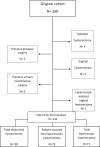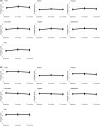Effects of hysterectomy on pelvic floor function and sexual function-A prospective cohort study
- PMID: 36004493
- PMCID: PMC9812090
- DOI: 10.1111/aogs.14437
Effects of hysterectomy on pelvic floor function and sexual function-A prospective cohort study
Abstract
Introduction: Hysterectomy is one of the most common major surgical procedures in women. The effects of hysterectomy on pelvic floor and sexual function are uncertain. Our objective was to investigate the effects of hysterectomy for benign indications on pelvic floor and sexual function and to compare different modes of surgery.
Material and methods: We performed a prospective clinical cohort study. In all, 260 women scheduled for hysterectomy answered validated questionnaires (Pelvic Floor Impact Questionnaire, Pelvic Floor Distress Inventory and Female Sexual Function Index). Participants were followed 6 months and 1 year after surgery. Data were analyzed using nonparametric statistics and mixed effect models.
Results: Women with subtotal hysterectomy, vaginal hysterectomy, laparoscopic assisted vaginal hysterectomy, and previous prolapse/incontinence surgery were excluded from further analysis, leaving the remaining cohort to 242 patients. The response rate at 6 months and 1 year follow-up was 180/242 (74.3%) and 169/242 (69.8%), respectively. There was an improvement of pelvic floor function at both follow-ups; mean score of Pelvic Floor Impact Questionnaire at baseline was 42.5 (51.7), at 6 months 19.9 (42.2) and at 1 year 23.7 (50.3) (p < 0.001). The mean score of Pelvic Floor Distress Inventory at baseline was 69.6 (51.1), at 6 months 49 (43.2) and at 1 year 49 (43.2) (p < 0.001). There was an improvement of sexual function after 6 months (mean score of Female Sexual Function Index at baseline 17.9 [SD 11.7] and at 6 months 21.0 [SD 11.7]) (p < 0.001). There was no difference in pelvic floor or sexual function when comparing surgical techniques.
Conclusions: Robotic assisted laparoscopic hysterectomy, laparoscopic hysterectomy and abdominal hysterectomy improve pelvic floor function to the same extent at 6 months and 1 year after surgery. There was an overall improvement of sexual function 6 months after hysterectomy, but this did not persist after 1 year.
Keywords: abdominal hysterectomy; female sexual function; laparoscopic hysterectomy; minimally invasive surgery; pelvic floor function; robotic assisted laparoscopic hysterectomy.
© 2022 The Authors. Acta Obstetricia et Gynecologica Scandinavica published by John Wiley & Sons Ltd on behalf of Nordic Federation of Societies of Obstetrics and Gynecology (NFOG).
Conflict of interest statement
Catharina Forsgren and Ulrika Johannesson received a clinical research grant from Intuitive Surgical. Martina Amato reports no conflicts of interest.
Figures




Similar articles
-
Pelvic floor and sexual function 3 years after hysterectomy - A prospective cohort study.Acta Obstet Gynecol Scand. 2024 Mar;103(3):580-589. doi: 10.1111/aogs.14751. Epub 2023 Dec 10. Acta Obstet Gynecol Scand. 2024. PMID: 38071460 Free PMC article.
-
Sexual function and pelvic floor function five years after hysterectomy.Acta Obstet Gynecol Scand. 2025 May;104(5):948-957. doi: 10.1111/aogs.15069. Epub 2025 Feb 25. Acta Obstet Gynecol Scand. 2025. PMID: 39996554 Free PMC article.
-
Vaginal versus robotic hysterectomy and concomitant pelvic support surgery: a comparison of postoperative vaginal length and sexual function.J Minim Invasive Gynecol. 2014 Nov-Dec;21(6):1010-4. doi: 10.1016/j.jmig.2014.04.011. Epub 2014 Apr 26. J Minim Invasive Gynecol. 2014. PMID: 24780383
-
Effects of bariatric surgery on pelvic floor disorders in obese women: a meta-analysis.Arch Gynecol Obstet. 2017 Aug;296(2):181-189. doi: 10.1007/s00404-017-4415-8. Epub 2017 Jun 22. Arch Gynecol Obstet. 2017. PMID: 28643025 Review.
-
Maintaining sexual function after pelvic floor surgery.Climacteric. 2019 Jun;22(3):236-241. doi: 10.1080/13697137.2018.1551870. Epub 2019 Jan 7. Climacteric. 2019. PMID: 30612484 Review.
Cited by
-
Innovative classification system for enlarged uterus in laparoscopic and robotic hysterectomy with complications and pain scores.J Robot Surg. 2025 Apr 28;19(1):183. doi: 10.1007/s11701-025-02369-3. J Robot Surg. 2025. PMID: 40295457
-
Pelvic floor and sexual function 3 years after hysterectomy - A prospective cohort study.Acta Obstet Gynecol Scand. 2024 Mar;103(3):580-589. doi: 10.1111/aogs.14751. Epub 2023 Dec 10. Acta Obstet Gynecol Scand. 2024. PMID: 38071460 Free PMC article.
-
The present adenomyosis treatment status in Luzhou, China: a small scope observational cross-sectional survey.BMC Womens Health. 2025 Feb 28;25(1):92. doi: 10.1186/s12905-025-03619-0. BMC Womens Health. 2025. PMID: 40022064 Free PMC article.
-
Pelvic Floor Therapy and Initial Interventions for Pelvic Floor Dysfunction in Gynecologic Malignancies.Curr Oncol Rep. 2024 Mar;26(3):212-220. doi: 10.1007/s11912-024-01498-6. Epub 2024 Jan 31. Curr Oncol Rep. 2024. PMID: 38294706 Review.
-
Evaluation of the effect of the type of hysterectomy on the incidence of stress urinary incontinence.Prz Menopauzalny. 2025 Mar;24(1):45-52. doi: 10.5114/pm.2025.150036. Epub 2025 Apr 28. Prz Menopauzalny. 2025. PMID: 40718016 Free PMC article. Review.
References
-
- Forsgren C, Lundholm C, Johansson ALV, Cnattingius S, Zetterström J, Altman D. Vaginal hysterectomy and risk of pelvic organ prolapse and stress urinary incontinence surgery. Int Urogynecol J. 2012;23:43‐48. - PubMed
MeSH terms
LinkOut - more resources
Full Text Sources
Medical

